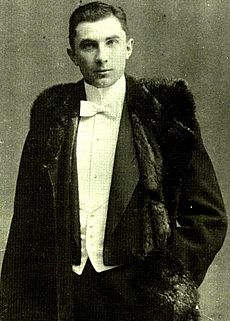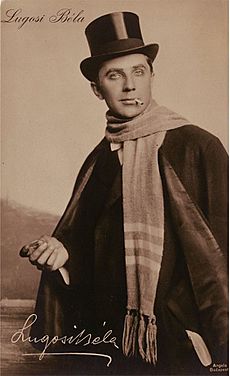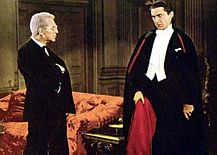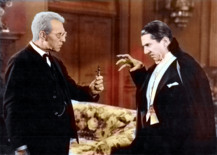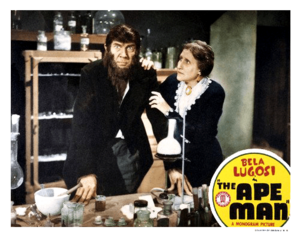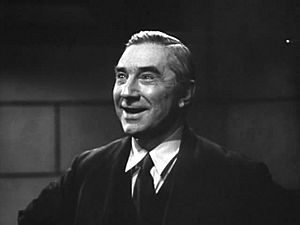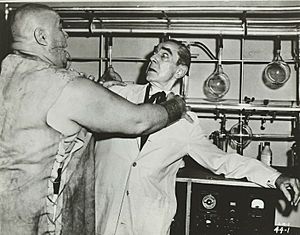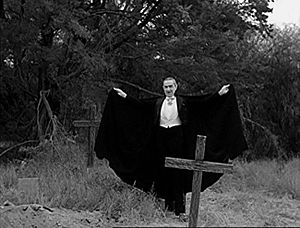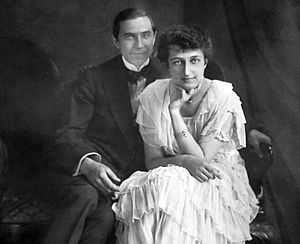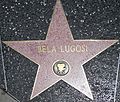Bela Lugosi facts for kids
Quick facts for kids
Bela Lugosi
|
|
|---|---|

Lugosi c. 1912
|
|
| Born |
Béla Ferenc Dezső Blaskó
October 20, 1882 Lugos, Kingdom of Hungary, Austria-Hungary
|
| Died | August 16, 1956 (aged 73) Los Angeles, California, U.S.
|
| Resting place | Holy Cross Cemetery |
| Other names | Arisztid Olt |
| Occupation | Actor |
| Years active | 1902–1956 |
| Spouse(s) |
|
| Children | Bela George Lugosi |
| Signature | |
 |
|
Béla Ferenc Dezső Blaskó (born October 20, 1882 – died August 16, 1956), known as Bela Lugosi, was an actor from Hungary. He is most famous for playing Count Dracula in the 1931 horror movie Dracula. He also appeared in many other horror films from 1931 to 1956.
Lugosi started acting on stage in Hungary in 1902. After performing in many plays, he began acting in Hungarian silent films in 1917. He had to leave Hungary suddenly in 1919 because of political problems related to his work with actors' unions. He left his first wife behind when he moved to Germany. He acted in several films in Germany before traveling to New Orleans as a sailor. From there, he made his way to New York City.
In 1927, Lugosi starred as Count Dracula in a play on Broadway. He then moved with the play to Hollywood in 1928. Later, he starred in the 1931 film version of Dracula, made by Universal Pictures. During the 1930s, he became very well known for horror films. However, his fame as "Dracula" and his strong Hungarian accent made it hard for him to get other types of roles. He tried for many years to avoid being typecast, but it was difficult.
He acted with Boris Karloff in several films. Karloff often received top billing, which means his name was shown first. Lugosi, who was one of the first members of the American Screen Actors Guild, often played mad scientists. Studios kept hiring him mainly so they could use his famous name on movie posters. Among his films with Karloff, he had important roles in The Black Cat (1934), The Raven (1935), and Son of Frankenstein (1939).
By this time, Lugosi was taking medicine for a painful nerve condition called sciatica. After the 1948 movie Abbott and Costello Meet Frankenstein, he received fewer offers for big roles. He started appearing in low-budget films, some of which were directed by Ed Wood. This included a short appearance in Wood's Plan 9 from Outer Space (1957), which was released after Lugosi had passed away.
Lugosi was married five times and had one son, Bela G. Lugosi, with his fourth wife, Lillian.
Early Life and Moving to America
Bela Lugosi was born Béla Ferenc Dezső Blaskó in 1882 in Lugos, Hungary. He was the youngest of four children. His father, István Blaskó, was a baker who later became a banker. His mother, Paula de Vojnich, was from Serbia. He grew up in a Roman Catholic family.
When he was 12, Lugosi left school and home to work at different jobs. His father died while he was away. He started his acting career on stage in 1902. In 1903, he chose the last name "Lugosi" to honor his birthplace. He performed in plays by Shakespeare. After moving to Budapest in 1911, he played many roles with the National Theatre of Hungary. Even though he later said he was a "leading actor," many of his roles were small. This led him to start acting in Hungarian films.
During World War I, he was a soldier in the Austro-Hungarian Army from 1914 to 1916. He became a Lieutenant and received a medal for injuries he got while fighting on the Russian front. After the war, Lugosi became an actor in Hungarian silent films. He often used the stage name "Arisztid Olt."
Because he was active in the actors' union in Hungary during the 1919 revolution, he had to leave his home country when the government changed. He first went to Vienna and then settled in Berlin, Germany. There, he started acting in German silent films. During these moves, his first wife, Ilona Szmik, lost her unborn child. She then left Lugosi and returned to her parents, where she divorced him.
Lugosi traveled to New Orleans, Louisiana in December 1920, working as a crew member on a ship. He then made his way to New York City, where he started acting in plays again in 1921. He also worked in silent films in New York from 1923 to 1926. In 1921, he married his second wife, Ilona von Montagh, who was also a Hungarian actress. They lived together for only a few weeks, but their divorce took until 1925 to be final.
He moved to California in 1928 to perform in the Dracula play. His film career in Hollywood then began. Lugosi said he performed the Dracula play about 1,000 times. He became a U.S. citizen in 1931, soon after his film Dracula was released.
Film Career
Early Films
Lugosi's first film was the 1917 Hungarian silent film Leoni Leo. In Hungarian silent films, he mostly used the stage name Arisztid Olt. Lugosi made at least 10 films in Hungary before leaving for Germany in 1918. After the government changed in Hungary in 1919, people involved in unions were in danger. Lugosi was not allowed to act because he helped form an actors' union. He moved to Germany and starred in at least 14 German silent films in 1920. These included Hypnose: Sklaven fremden Willens (1920) and Der Januskopf (1920).
Lugosi left Germany in October 1920 and came to the United States by ship. He arrived in New Orleans in December 1920 and was checked by immigration officers at Ellis Island in March 1921. He officially said he wanted to become a US citizen in 1928 and became one in 1931.
When he first arrived in America, Lugosi worked as a laborer. Then, he started acting in Hungarian plays in New York City. He formed a small acting group with other Hungarian actors that toured cities in the East. Lugosi acted in several Hungarian plays before his first English play on Broadway, The Red Poppy, in 1922. He had three more roles in 1925–26, including a five-month run in The Devil in the Cheese.
His first American film role was in the silent movie The Silent Command (1923), filmed in New York. He played villains and foreign characters in four other silent films made in the New York area. There was a rumor that Lugosi played a clown in the 1924 film He Who Gets Slapped. However, historians believe this is very unlikely because Lugosi was in Chicago and New York when that film was made in Hollywood.
Dracula
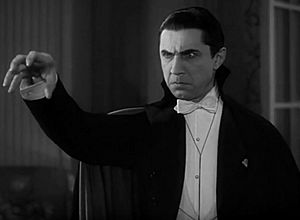
In the summer of 1927, Lugosi was asked to star in a Broadway theatre play of Dracula. The play was based on Bram Stoker's 1897 novel. The play was very successful in New York City, running for 261 performances. It then toured the United States in 1928 and 1929. In 1928, Lugosi decided to stay in California when the play finished its first run there. His performance caught the attention of Fox Film, and he was cast in their silent film The Veiled Woman (1929). He also appeared in the film Prisoners (1929), which is now believed to be lost.
In 1929, with no other film roles, he returned to the stage as Dracula for a short tour. Lugosi stayed in California and continued to work in films for Fox. He often played villains or "exotic" characters in early talkie films. He also kept trying to get the main role in the film version of Dracula.
Even though he was praised for his stage performance, Lugosi was not Universal Pictures' first choice for the role of Dracula. Many other famous actors were considered. Lugosi had played the role on Broadway, and director Tod Browning eventually cast him. The film was a huge success, but Lugosi was only paid $3,500 because he was so eager to get the role.
Typecasting and Later Career

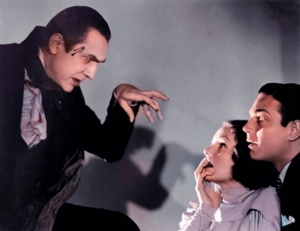
Because of his role in Dracula, Lugosi became known for playing horror villains. He appeared in films like Murders in the Rue Morgue (1932), The Black Cat (1934), The Raven (1935), and White Zombie (1932). His accent, while part of his famous image, made it hard for him to play other kinds of roles.
Lugosi tried to get roles that were not horror. He tried out for parts in other films but often lost them to other actors. He did play a general in International House (1933).
Lugosi often worked with Boris Karloff in films like The Black Cat (1934), The Raven (1935), and Son of Frankenstein (1939). Lugosi usually received second billing, meaning Karloff's name was listed first. Some people say Lugosi was jealous of Karloff's success, while others say they got along well. Karloff said Lugosi was careful at first but then they worked together nicely. Lugosi did get a few heroic roles, but his problem with being typecast was too strong.
In 1937, Lugosi or his agent wrote in a film directory that it was "an error" to think he was only good for horror films. He wanted to play other roles.
Career Decline

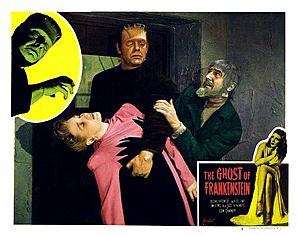
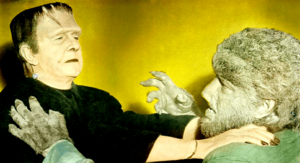
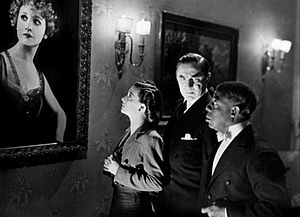
In 1938, Bela Lugosi's popularity grew when a theater owner showed Dracula and Frankenstein together. This double feature was very popular. Lugosi appeared in person, which excited new audiences. Universal Pictures noticed this success and re-released the films. They then hired Lugosi for new movies, which was good timing as his fourth wife had just had a son.
Universal cast Lugosi in Son of Frankenstein (1939) as Ygor, a blacksmith with a broken neck. Lugosi was third-billed after Basil Rathbone and Boris Karloff. The film's director said Lugosi "stole the show" with his performance.
That same year, Lugosi appeared in a rare A-list movie: the comedy Ninotchka, starring Greta Garbo. Lugosi played a Soviet official and received top billing among the supporting actors. This could have been a turning point for him, but soon he was back in low-budget films. These horror, comedy, and mystery films were mostly released by Monogram Pictures.
Lugosi went to 20th Century-Fox for The Gorilla (1939), where he played a serious butler. In 1940, Lugosi appeared in person at a theater in Chicago for the premiere of his film Black Friday.
Lugosi suffered from severe, long-lasting sciatica, possibly from his military service. He was cast as Frankenstein's monster in Universal's Frankenstein Meets the Wolf Man (1943). However, his lines were cut from the film after it was made. This made his performance seem strange to audiences. Lugosi played Dracula for the second and last time in the film Abbott and Costello Meet Frankenstein (1948).
Abbott and Costello Meet Frankenstein was Bela Lugosi's last major film. For the rest of his life, he appeared less often in small, low-budget films. From 1947 to 1950, he performed in plays, often Dracula, and made personal appearances in "spook shows" and on early television.
In 1949, Milton Berle invited Lugosi to appear on his TV show. Lugosi also appeared on the show Suspense in 1949, in a live play based on "The Cask of Amontillado".
In 1951, while in England for a Dracula tour, Lugosi starred in a comedy film called Mother Riley Meets the Vampire. After returning to the U.S., he was interviewed for television and sadly spoke about being typecast: "Now I am the boogie man". He also said he wanted to play more comedy roles. Producer Jack Broder then cast him in a jungle comedy, Bela Lugosi Meets a Brooklyn Gorilla (1952).
Stage and Personal Appearances
Lugosi had a busy career on stage and made many personal appearances. As film offers decreased, he relied more on live shows to support his family. Lugosi took over the role of Jonathan Brewster in the play Arsenic and Old Lace. He also made many live appearances to promote his horror image or a film.
The film House of Wax premiered in Los Angeles in 1953. Producer Alex Gordon knew Lugosi needed money, so he arranged for the actor to stand outside the theater wearing a cape and dark glasses, holding a person dressed as a gorilla on a leash. Lugosi was also photographed drinking milk at a Red Cross booth.
Ed Wood and Final Projects
Later in his life, Bela Lugosi again received star billing in films when filmmaker Ed Wood found him living in poverty. Wood, a fan of Lugosi, offered him roles in his films, such as a narrator in Glen or Glenda (1953) and a mad scientist in Bride of the Monster (1955). During the making of Bride of the Monster, Lugosi decided to seek treatment for his health issues. The film's premiere was held to raise money for Lugosi's hospital expenses. According to a biography of Frank Sinatra, when Sinatra heard about Lugosi's problems, he visited him in the hospital and gave him a $1,000 check.
After leaving the treatment center in 1955, Lugosi said he was about to start a new Ed Wood film called The Ghoul Goes West. Wood filmed some test footage with Lugosi in his Dracula cape, without a specific story. This footage was later used in Wood's film Plan 9 from Outer Space (1957), which was filmed after Lugosi died. Wood hired Tom Mason, his wife's chiropractor, to stand in for Lugosi in extra shots. Mason was taller and thinner than Lugosi, and his face was covered by his cape in every shot.
Lugosi made one final film in late 1955, The Black Sleep. It was released in 1956. In this film, Lugosi played a mute butler with no lines. He never saw the finished movie.
In 1959, a British film called Lock Up Your Daughters was released, which used clips from Bela Lugosi's films from the 1940s.
Personal Life
Lugosi was married five times. In June 1917, he married 19-year-old Ilona Szmik in Hungary. They divorced after Lugosi had to leave Hungary for political reasons, and Ilona did not want to leave her parents. The divorce was final in 1920.
After living in Germany, Lugosi arrived in New Orleans in October 1920 and then at Ellis Island in New York in March 1921.
In September 1921, he married Hungarian actress Ilona von Montagh in New York City. She filed for divorce in 1924, and it was final in October 1925.
Lugosi married Beatrice Woodruff Weeks in Hollywood in July 1929. She was a wealthy widow. Weeks filed for divorce in November 1929, and it was final in December 1929. Weeks died 17 months later.
On June 26, 1931, Lugosi became a United States citizen.
In 1933, 51-year-old Lugosi married 22-year-old Lillian Arch. Her parents were Hungarian immigrants. Lillian's father was against the marriage at first because Lugosi was having money problems. Bela convinced her to elope with him to Las Vegas in January 1933. They were married for twenty years and had a son, Bela G. Lugosi, in 1938.
Lillian and Bela often vacationed at their property in Lake Elsinore, California. Their son, Bela Jr., lived with Lillian's parents while his parents were touring.
Lillian and Béla divorced on July 17, 1953. Lillian received custody of their son, Bela Jr. Lillian later married actor Brian Donlevy in 1966. She passed away in 1981.
Lugosi married Hope Lininger, his fifth wife, in 1955. She was 37 years younger than him. She had been a fan and wrote letters to him when he was in the hospital. They were married until his death in 1956.
Death
Bela Lugosi died of a heart attack on August 16, 1956, in his Los Angeles apartment. He was taking a nap and passed away peacefully in his sleep around 6:45 PM. He was 73 years old.
Lugosi was buried wearing one of his "Dracula" capes and his Dracula ring at the Holy Cross Cemetery in Culver City, California. His son, Bela G. Lugosi, confirmed that he and his mother, Lillian, decided to bury him in the cape because they believed it's what his father would have wanted.
The funeral was held on August 18. Attendees included Forrest J. Ackerman, Ed Wood, Tor Johnson, and Lugosi's two widows, Hope and Lillian, and his son, Bela Lugosi Jr. Bela's fourth wife, Lillian, paid for the grave plot and stone. Hope Lugosi paid for the coffin and funeral service. Lugosi's will left some property and $1,000 cash to his son. Since the will was written before his fifth marriage, his son had to share the money with Hope Lugosi.
Hope later gave most of Lugosi's personal items to his young friend Richard Sheffield. Hope moved to Hawaii and worked as a caregiver. She passed away in Hawaii in 1997.
Legacy
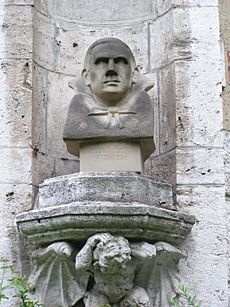
In Tim Burton's film Ed Wood, Bela Lugosi is played by Martin Landau, who won an Academy Award for his performance. However, Lugosi's son and others who knew him say the film's portrayal of Lugosi is not completely accurate. For example, he did not use bad language, did not hate Karloff, and did not own small dogs. Also, Ed Wood met Lugosi through his roommate, not in a funeral home.
An episode of the TV show Sledge Hammer! was a tribute to Bela Lugosi.
In 2001, a radio play called There Are Such Things focused on Lugosi's struggle to escape his typecast role. It won an award from the Dracula Society.
On July 19, 2003, German artist Hartmut Zech put up a bust (a sculpture of his head and shoulders) of Lugosi at Vajdahunyad Castle in Budapest.
The Ellis Island Immigration Museum in New York City has a play about Lugosi's journey to America.
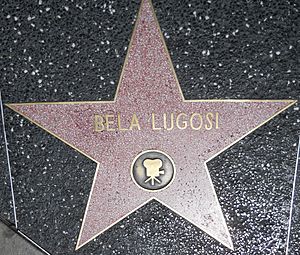
The cape Lugosi wore in Dracula (1931) was owned by his son until it was put up for auction in 2011. In 2019, the Academy Museum of Motion Pictures announced they had acquired the cape.
Péter Müller's play Lugosi – the Shadow of the Vampire is based on Lugosi's life.
Andy Warhol's 1963 artwork The Kiss shows Lugosi from Dracula about to bite Helen Chandler's neck. A copy of this artwork sold for $798,000 in 2000.
In 1979, the song "Bela Lugosi's Dead" was released by the band Bauhaus. It is considered a very important song in the Goth music style. The band's bassist, David J, said he wrote the song because he loved old horror films, especially Dracula with Bela Lugosi.
Bela Lugosi and Boris Karloff are mentioned in the song "Sleeping with the Lights On" by Curtis Stigers.
Lugosi's star on the Hollywood Walk of Fame is mentioned in the song "Celluloid Heroes" by The Kinks.
In 2013, the Hungarian electronic music band Žagar recorded a song called "Mr. Lugosi," which includes a recording of Bela Lugosi's voice.
According to Paru Itagaki, the creator of the Japanese manga/anime Beastars, the main character Legoshi was inspired by Bela Lugosi.
In 2020, Legendary Comics published a graphic novel of Bram Stoker's Dracula that used Lugosi's likeness.
A 2021 graphic novel about Bela Lugosi's life, called Lugosi: The Rise and Fall of Hollywood's Dracula, was written and drawn by Koren Shadmi.
Images for kids
-
Bela Lugosi as Count Dracula in 1931
-
Edward Van Sloan as Van Helsing and Lugosi as Dracula (1931)
-
Edward Van Sloan as Van Helsing and Lugosi as Dracula (1931)
-
Warner Oland and Lugosi in The Black Camel (1931)
-
Lugosi in Mark of the Vampire (1935) with Elizabeth Allen and Henry Wadsworth
-
Boris Karloff as Frankenstein's monster, Basil Rathbone as Dr. Frankenstein's son, and Lugosi as Ygor in Son of Frankenstein (1939)
-
Lon Chaney Jr. as Frankenstein's monster, Evelyn Ankers, and Lugosi as Ygor in The Ghost of Frankenstein (1942)
-
Lugosi as Frankenstein's monster and Lon Chaney Jr. as the Wolf Man in Frankenstein Meets the Wolf Man (1943)
-
Lugosi (center) with Polly Ann Young and Clarence Muse in The Invisible Ghost (1941)
-
Bust of Lugosi on Vajdahunyad Castle in Budapest, Hungary.
-
Lugosi's star on the Hollywood Walk of Fame
See also
 In Spanish: Béla Lugosi para niños
In Spanish: Béla Lugosi para niños


